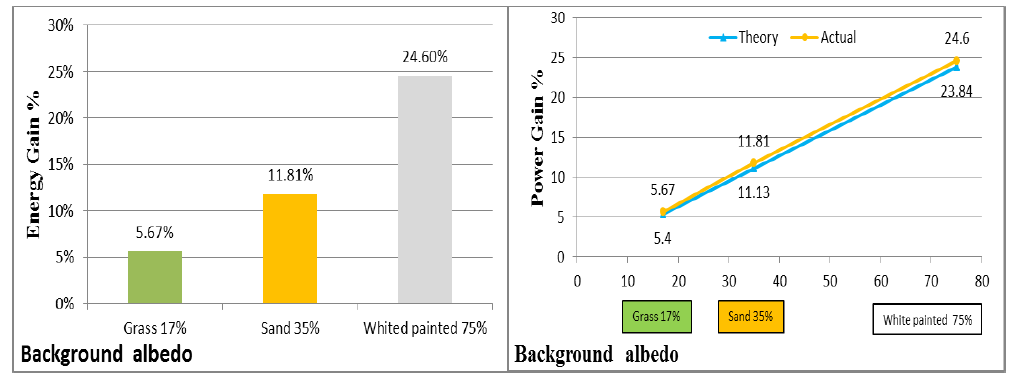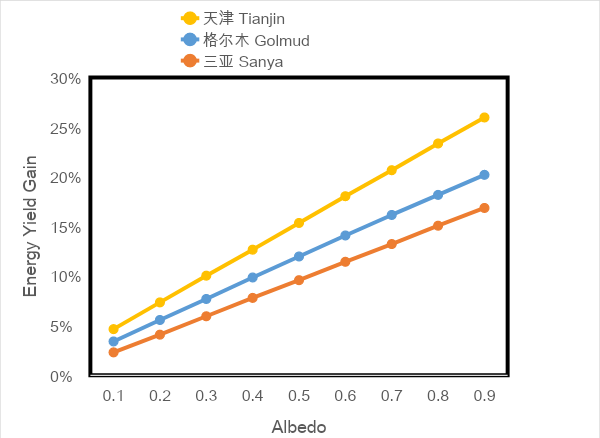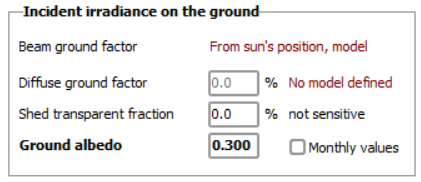Albedo: A key factor for assessing bifacial gain
- 22/11/04
- Reliability,Utility,Customer Value,Innovation and Advance
We can define the albedo as the ratio of the reflected irradiance (RI) to the global horizontal irradiance (GHI) received by the ground surface. It is a dimensionless value that can range from 1 (a perfect reflector) to 0 (a perfect absorber). The albedo varies with the color and characteristics of the surfaces that reflect light onto the rear of a module. Lightly-colored and smooth surfaces have high albedos that can lead to high energy output from the rear of a module.
Despite its apparent simplicity, accurate estimations of the levels of albedo radiation involve complex boundary conditions. This is because they depend on multiple factors, such as the ground surface properties and the spectral and angular distribution of solar radiation reaching the ground. These factors vary depending upon the composition of the atmosphere, the geographic location, and the time. As a result, the albedo varies throughout the year (intra-annually) and over the years (inter-annually).
Intra-annual variability is mainly affected by seasonal variation of ground cover related to vegetation growth, the sun's position, and atmospheric factors, which may lead to significant variations in albedo levels throughout the year.
Inter-annual variability is conditioned by year-by-year changes to vegetation growth and atmospheric conditions, such as climate and aerosol optical depth. Since inter-annual variability is strongly related to vegetation growth, its impact will be lower on desert lands than on meadows or grazing and cropping lands.
Albedo is the main factor affecting how much solar radiation the ground surface reflects. As such, it is a key factor when assessing bifacial gain. We must be able to accurately estimate the evolution of albedo irradiation throughout an entire year to calculate the energy output of a bifacial PV project.
Trina Solar has repeatedly tested the generating capacity gain of our bifacial modules under different surface circumstances. One project, for example, involved a conventional monocrystalline PERC dual glass module with the following configuration data:
- Unsheltered installation in fixed-tilt configuration with a tilt angle of 27°
- Module height at least 0.4m above the ground.
The following figure 1 (on the left) and table 1 mainly compares the data on sunny days. With the fixed-tilt installation method, the generating capacity gain increases gradually with the increase of ground surface reflectance. The generating capacity gain is around 20% in the case of white paint.

Figure 1. Bifacial gain affection by different albedos (different surfaces)

The right part of above figure shows the contrast between simulated and practical generating capacity gain with installations on different ground surfaces. The theoretically simulated value is approximately equal to the practical value. The generating capacity gain corresponding to other surface reflectances is also roughly determinable from the curve.
Moreover, we must analyze the impact of the latitude on the bifacial gain related to different albedos. For this purpose, our team at Trina Solar has performed a bifacial gain (energy yield) test campaign on three different cities/locations within China with different latitudes, as detailed in Table 2.

As Figure 2 shows, high latitude sites typically imply a bigger pitch and greater tilt inclination. Bifacial gain (and therefore yield) is more sensitive to albedo changes in this situation. This becomes clear when comparing the Tianjin and Sanya locations, for example.
Please note that the previous conclusion is subject to land constraints (or other factors) that prevent bigger pitches at higher latitude sites.

Figure 2. Bifacial gain is affected by different location latitude
Albedo is one of the most critical variables for configuration when simulating yearly energy production for a bifacial PV plant with the PVsyst® simulation package. Albedo data availability for a specific project location can be either the average annual or a more accurate monthly basis (if data is available).

Figure 3. Albedo parameter configuration in PVsyst®
For more, read Trina Solar’s Ultimate Guidebook for Bifacial System Design
This blog post is original content from Trina Solar’s free Ultimate Guidebook for Bifacial System Design. To learn more about key factors to consider when planning solar power stations with bifacial modules, and the benefits these modules can bring to any solar project, download this valuable resource today!

